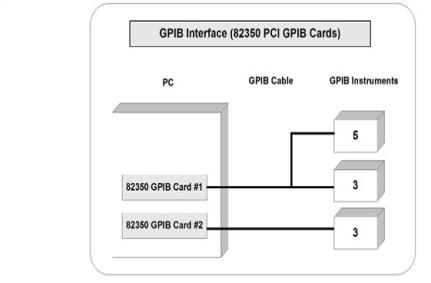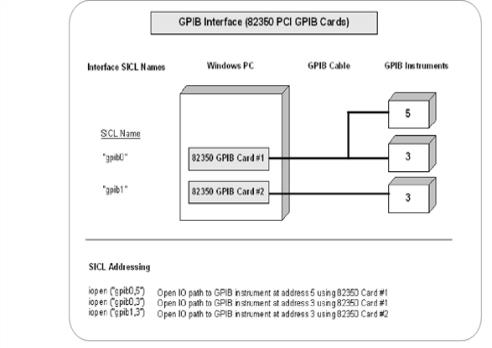Introduction to GPIB Interfaces
This topic provides an introduction to using SICL with the GPIB interface. This provides an overview of GPIB interfaces, including typical hardware configuration using the Connection Expert utility, and example configurations using SICL.
The subtopics are:
- Typical GPIB Interface
- Configuring GPIB Interfaces
- Selecting a GPIB Communications Session
- SICL GPIB Functions
Typical GPIB Interface
As shown in the following figure, a typical GPIB interface consists of a Windows PC with one or more GPIB cards (PCI and/or ISA) cards installed in the PC and one or more GPIB instruments connected to the GPIB cards via GPIB cable. I/O communication between the PC and the instruments is via the GPIB cards and the GPIB cable. This figure shows GPIB instruments at addresses 3 and 5.

Configuring GPIB Interfaces
An IO interface can be defined as both a hardware interface and as a software interface. One function of Connection Expert is to associate a unique interface name with a hardware interface.
SICL uses an Interface Name or Logical Unit Number to identify an interface. This information is passed in the parameter string of the iopen function call in a SICL program. Connection Expert assigns a default Interface Name and Logical Unit Number, as well as other necessary configuration values, when the interface hardware is configured; you can change these values by running the Connection Expert utility.
Example: GPIB (82350) Interface
The GPIB interface system in the following figure consists of a Windows PC with two 82350 GPIB cards connected to three GPIB instruments via GPIB cables. For this system, Connection Expert has been used to assign GPIB card #1 a SICL name of gpib0 and to assign GPIB card #2 a SICL name of gpib1. With these names assigned to the interfaces, the SICL addressing is as shown in the figure. Since unique names have been assigned by Connection Expert, you can use the iopen command to open the I/O paths shown.
|
|
Selecting a GPIB Communications Session
When you have determined the GPIB system is set up and operating correctly, you can start programming with the SICL functions. First, you must determine what type of communications session to use.
The three types of communications sessions are:
- Device - See Using GPIB Device Sessions
- interface - See Using GPIB Device Sessions
- Commander. - See Using GPIB Device Sessions
SICL GPIB Functions
|
Function Name |
Action |
|
igpibatnctl |
Sets or clears the ATN line. |
|
igpibbusaddr |
Changes bus address. |
|
igpibbusstatus |
Returns requested bus data. |
|
igpibgett1delay |
Returns the current T1 setting for the interface. |
|
igpibllo |
Sets bus in Local Lockout Mode. |
|
igpibpassctl |
Passes active control to specified address. |
|
igpibppoll |
Performs a parallel poll on the bus. |
|
igpibppollconfig |
Configures device for PPOLL response. |
|
igpibppollresp |
Sets PPOLL state. |
|
igpibrenctl |
Sets or clears the REN line. |
|
igpibsendcmd |
Sends data with ATN line set. |
|
igpibsett1delay |
Sets the T1 delay value for this interface. |
